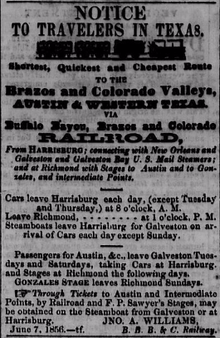Buffalo Bayou, Brazos and Colorado Railway
| Overview | |
|---|---|
| Headquarters | standard gauge |
The Buffalo Bayou, Brazos, and Colorado Railway (B.B.B.C. or B.B.B. & C.), also called the Harrisburg Road or Harrisburg Railroad, was the first operating
Name

The Colorado in its name refers to the Colorado River of Texas, not the state of Colorado. In the line's early days, it was often called the Harrisburg Road or the Harrisburg Railroad. In 1868, it changed owners and became the Galveston, Harrisburg, & San Antonio Railroad (reporting mark GHSA).[1] It was the oldest component of the Southern Pacific system (reporting mark SP). Since the 1996 merger, the former Southern Pacific operates under the Union Pacific name. The old Buffalo Bayou, Brazos and Colorado right-of-way was renamed the Union Pacific-Glidden Subdivision, operating between Alleyton, Texas and the former Harrisburg, Texas, which was annexed by Houston.[2]
History
| History of Texas | ||||||||||||||||||
|---|---|---|---|---|---|---|---|---|---|---|---|---|---|---|---|---|---|---|
 | ||||||||||||||||||
| Timeline | ||||||||||||||||||
|
||||||||||||||||||
|
| ||||||||||||||||||

Andrew Briscoe initiated the first attempt to establish a railroad from Harrisburg, Texas, to the Brazos and Colorado Rivers. Houston's Morning Star published a notice on May 16, 1840, entitled "Harrisburg and Brazos Railroad," that claimed, "A large number of laborers are engaged at present in throwing up the track and preparing for rails at an early season, and a greater number will soon be employed."[3]
The first successful attempt to establish a Harrisburg Railroad line was
Surveying began in 1851 near
With the financial collapse of Texas during

Sometimes the line is represented as originating in
At the end of 1924 (before adding SA&AP), it operated 1,380 miles (2,220 km) of railroad on 1,890 miles (3,040 km) of track.[citation needed]
Locomotives
| Name | Builder | s/n | Build date | Whyte type | Notes |
|---|---|---|---|---|---|
| General Sherman | Baldwin | 4-2-0 | Purchased on October 12, 1852; named for Sidney Sherman; sold July 1870 to GH&SA; quickly off roster. | ||
| Texas | |||||
| Austin | Lowell | 139 | 1854 | 4-4-0 | Sold July 1870 to GH&SA; off roster by 1884. |
| Columbus | Hinkley | 1857 | 4-4-0 | Sold July 1870 to GH&SA; off roster by 1882. | |
| Richmond | Norris | August 1859 | 4-4-0 | Sold July 1870 to GH&SA; off roster by 1882. | |
| Harrisburg | Hinkley | 660 | [6] | ||
| Harrisburg | Norris | August 1859 | 4-4-0 | Sold July 1870 to GH&SA; off roster by 1882. | |
| Ames | Purchased in October 1868 | ||||
| Barrett | Purchased in October 1868; sold July 1870 to GH&SA; pulled the first train into San Antonio in February 1877 |
See also
References
- ^ The Official Railway Equipment Register. Railway Equipment and Publication Company. 1917. p. 667.
- ^ "Houston Region Freight Rail Study" (PDF). Texas Department of Transportation. p. 101. Retrieved July 20, 2013.
- JSTOR 27784974.
- ^ a b Reed, S. G. (1941). A History of Texas Railroads. Houston: St.Clair Publishing. pp. 54–57.
- ^ a b Werner, George C. (June 12, 2010). "BUFFALO BAYOU, BRAZOS AND COLORADO RAILWAY". Texas Handbook Online. Texas State Historical Association. Retrieved July 20, 2013.
- ^ Railroad History (144). Railway & Locomotive Historical Society. 1981.
{{cite journal}}: Missing or empty|title=(help)
